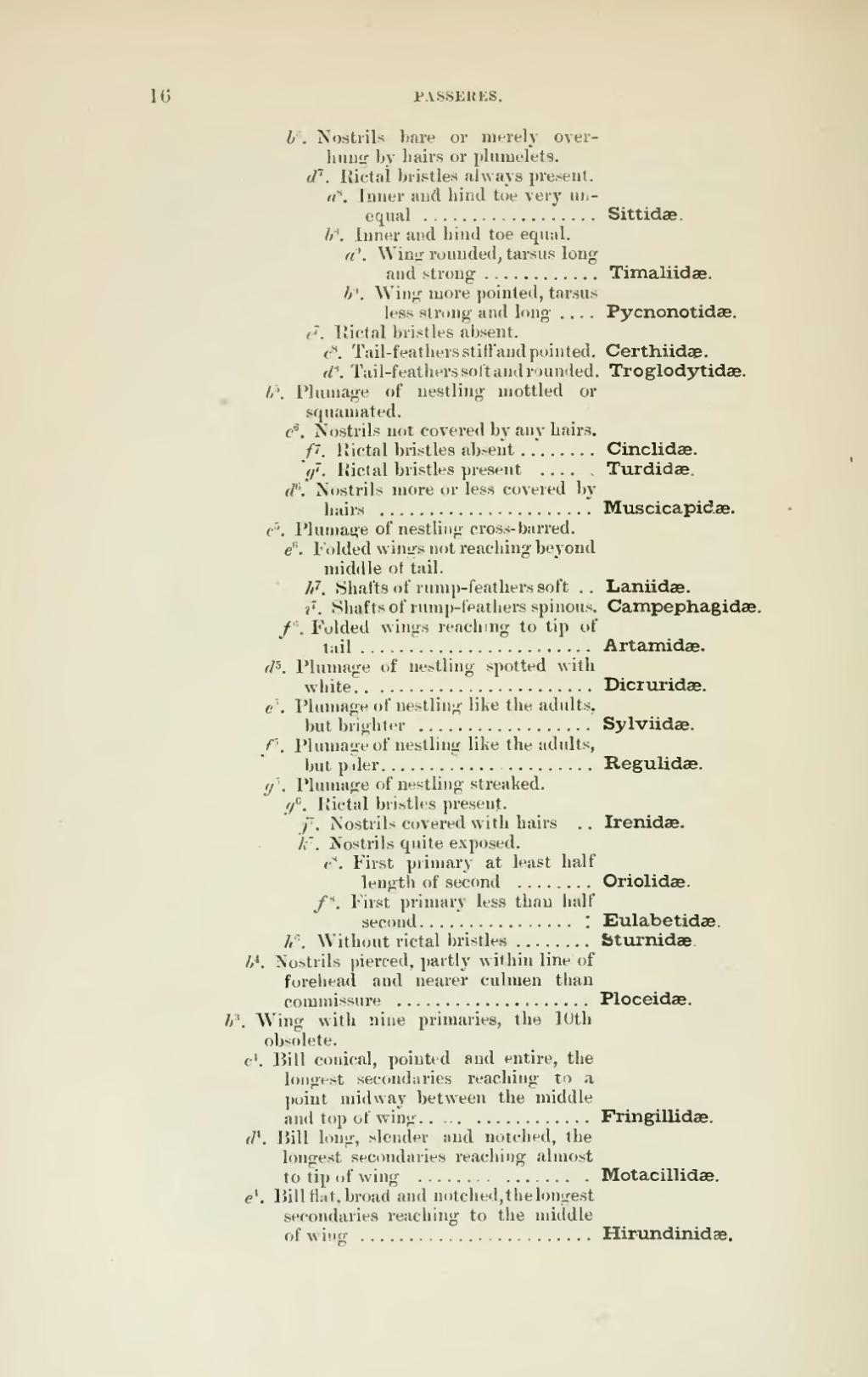This page has been validated.
16
PASSERES.
| b6. |
Nostrils bare or merely overhung by hairs or plumelets.
|
| d7. |
Rictal bristles always present.
|
| a8. |
Inner and hind toe very unequal
....................................................................................................................................................................................................................................................
|
Sittidæ. |
| b8. |
Inner and hind toe equal.
|
| a9. |
Wing rounded, tarsus long and strong
....................................................................................................................................................................................................................................................
|
Timaliidæ. |
| b9. |
Wing more pointed, tarsus less strong and long
....................................................................................................................................................................................................................................................
|
Pycnonotidæ. |
| e7. |
Rictal bristles absent.
|
| c8. |
Tail-feathers stiff and pointed
....................................................................................................................................................................................................................................................
|
Certhiidæ. |
| d8. |
Tail-feathers soft and rounded
....................................................................................................................................................................................................................................................
|
Troglodytidæ. |
| b5. |
Plumage of nestling mottled or
squamated.
|
| c6. |
Nostrils not covered by any hairs.
|
| f7. |
Rictal bristles absent
....................................................................................................................................................................................................................................................
|
Cinclidæ. |
| g7. |
Rictal bristles present
....................................................................................................................................................................................................................................................
|
Turdidæ. |
| d6. |
Nostrils more or less covered by
hairs
....................................................................................................................................................................................................................................................
|
Muscicapidæ. |
| c5. |
Plumage of nestling cross-barred.
|
| e6. |
Folded wings not reaching beyond middle of tail.
|
| h7. |
Shafts of rump-feathers soft
....................................................................................................................................................................................................................................................
|
Laniidæ. |
| i7. |
Shafts of rump-feathers spinous
....................................................................................................................................................................................................................................................
|
Campephagidæ. |
| f6. |
Folded wings reaching to tip of
tail
....................................................................................................................................................................................................................................................
|
Artamidæ. |
| d5. |
Plumage of nestling spotted with white
....................................................................................................................................................................................................................................................
|
Dicruridæ. |
| e5. |
Plumage of nestling like the adults, but brighter
....................................................................................................................................................................................................................................................
|
Sylviidæ. |
| f5. |
Plumage of nestling like the adults, but paler
....................................................................................................................................................................................................................................................
|
Regulidæ. |
| g5. |
Plumage of nestling streaked.
|
| g6. |
Rictal bristles present.
|
| j7. |
Nostrils covered with hairs
....................................................................................................................................................................................................................................................
|
Irenidæ. |
| k7. |
Nostrils quite exposed.
|
| e8. |
First primary at least half length of second
....................................................................................................................................................................................................................................................
|
Oriolidæ. |
| f8. |
First primary less than half second
....................................................................................................................................................................................................................................................
|
Eulabetidæ. |
| h6. |
Without rictal bristles
....................................................................................................................................................................................................................................................
|
Sturnidæ. |
| b4. |
Nostrils pierced, partly within line of forehead and nearer culmen than commissure
....................................................................................................................................................................................................................................................
|
Ploceidæ. |
| b3. |
Wing with nine primaries, the 10th obsolete.
|
| c4. |
Bill conical, pointed and entire, the longest secondaries reaching to a point midway between the middle and top of wing
....................................................................................................................................................................................................................................................
|
Fringillidæ. |
| d4. |
Bill long, slender and notched, the longest secondaries reaching almost to tip of wing
....................................................................................................................................................................................................................................................
|
Motacillidæ. |
| e4. |
Bill flat, broad and notched, the longest secondaries reaching to the middle of wing
....................................................................................................................................................................................................................................................
|
Hirundinidæ. |
